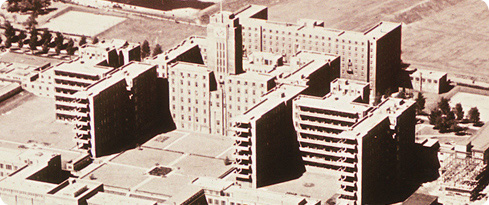Your views

Your feedback is vital to us as we continue to increase the quality of our services.
You are here:
Date: 20 December 2024
Time: 15:18
Significance of the QEH building and short-term factors
For the first decades of the twentieth century, individual hospitals were enlarged, rebuilt and relocated.
Competition for funds also grew more intense with each year, especially with the appearance of new specialist hospitals, including the Maternity Hospital at Loveday Street (1907) and the Midland Nerve Hospital on Bath Row (1914).
Besides this heightened competition for funds, it was also recognised that there was much duplication of the services these hospitals offered and the cases they treated. For example, the Children’s Hospital treated Birmingham’s youngest patients, but so did the General and Queen’s Hospitals, as well as the more specialised orthopaedic, eye, ear and skin charities.
New technologies were also regarded as necessary by staff at each institution, and building a radiology department at each individual hospital was not regarded as financially viable. As a result, cooperation between institutions with similar missions began. This included the Women's and Maternity hospitals, which merged in 1911.
A number of smaller medical charities also began to rely on the General and Queen’s hospitals in order to gain access to radiology equipment, as well as bacteriological laboratories.
A Hospital Centre in Edgbaston was first proposed in 1922, when Alderman WA Cadbury opposed the extension of the General Hospital. Though many opposed the proposal and an extension at the General was permitted to proceed, the idea gradually gained support.
An appeal to build a new Hospital Centre in the city’s suburbs was launched in April 1930 and by the end of 1931 donations surpassed £600,000.
By 1929, plans had advanced considerably and it was decided that clinical teaching in the new 600-bed Hospital Centre would include:
- medicine
- surgery
- therapeutics
- midwifery
- diseases of women
- ophthalmology
- diseases of the ear, nose and throat
- orthopaedics
- dermatology
- venereal disease
- radiology
An image of the Queen Elizabeth Hospital in construction is featured below.

Though a central hospital reduced the time required for students to travel between individual teaching hospitals and the university, doubts about establishing every specialist department in the new hospital existed and the concept of associated teaching hospitals continued to receive support.
A Department of "Mental Medicine", or psychiatry, was also to be established and would greatly improve the place of this specialty in the Medical School curriculum.
In 1933, an Act of Parliament amalgamated the General and Queen’s hospitals and renamed them the Birmingham United Hospital. On 1 January 1935, the two original teaching hospitals began to issue a joint annual report. The Hospitals Centre was finally occupied on 1 November 1938, a week ahead of schedule. A photograph of the Queen Elizabeth Hospital after completion is featured below.

The hospital, which comprised the Vincent Medical Block, Cadbury Surgical Block and Nuffield House Nurses' Home, received its first royal visit on 1 March 1939, on which day the Queen offered her name to the institution.
For some time, the fate of the Queen’s Hospital had caused some concern locally. With the new royal title, however, the legacy of the city’s second general hospital was perpetuated, even if named after another queen.
The old buildings were originally to be taken over by the Maternity Hospital in Loveday Street, which would also later move to Edgbaston.
In 1941, a century after it was founded, the Queen’s Hospital was re-inaugurated as the Birmingham Accident Hospital. The General Hospital at Steelhouse Lane continued to admit patients until 1993.
Related pages

Getting here
Information about travelling to, staying at and getting around the hospital.

Jobs at UHB
A great place to work. Learn why.


